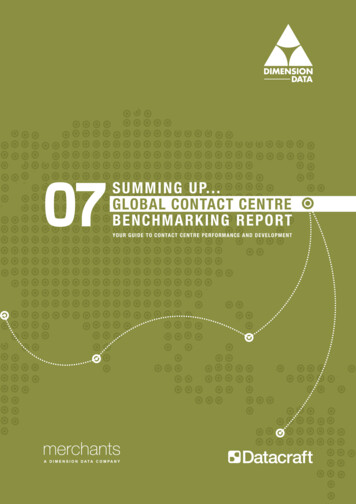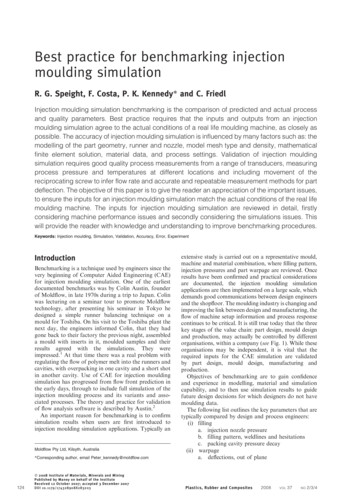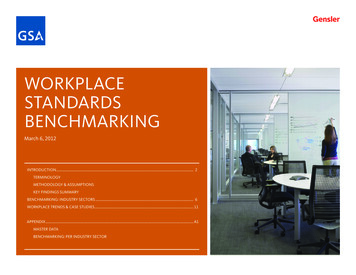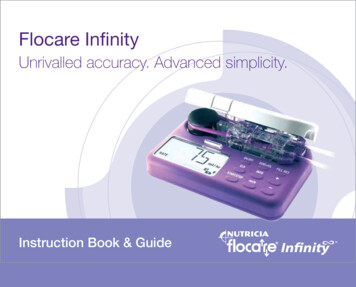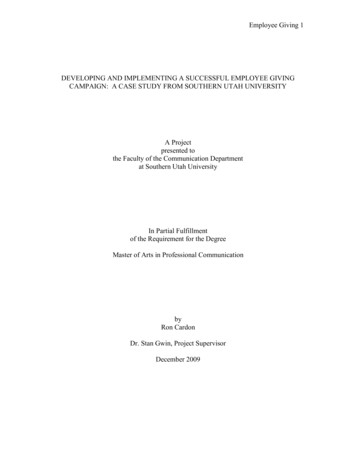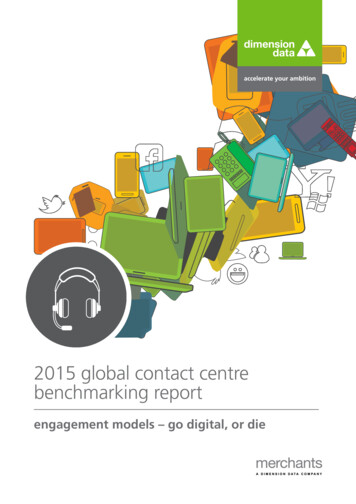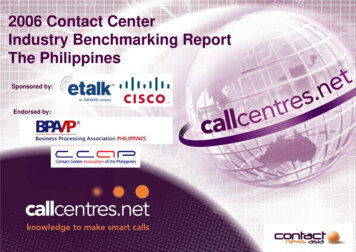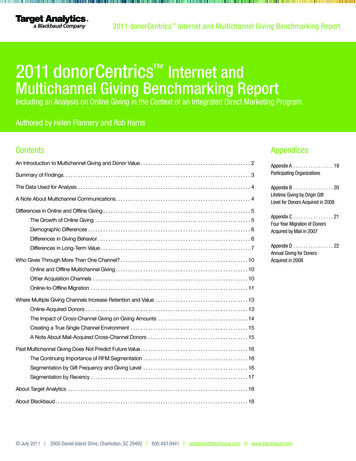
Transcription
2011 donorCentrics Internet and Multichannel Giving Benchmarking Report2011 donorCentrics Internet andMultichannel Giving Benchmarking ReportIncluding an Analysis on Online Giving in the Context of an Integrated Direct Marketing ProgramAuthored by Helen Flannery and Rob HarrisContentsAn Introduction to Multichannel Giving and Donor Value. . . . . . . . . . . . . . . . . . . . . . . . . . . . . . . . . . . . . . . . . . . . . 2Summary of Findings. . . . . . . . . . . . . . . . . . . . . . . . . . . . . . . . . . . . . . . . . . . . . . . . . . . . . . . . . . . . . . . . . . . . . . . . . . . 3The Data Used for Analysis. . . . . . . . . . . . . . . . . . . . . . . . . . . . . . . . . . . . . . . . . . . . . . . . . . . . . . . . . . . . . . . . . . . . . . 4A Note About Multichannel Communications. . . . . . . . . . . . . . . . . . . . . . . . . . . . . . . . . . . . . . . . . . . . . . . . . . . . . . 4Differences in Online and Offline Giving. . . . . . . . . . . . . . . . . . . . . . . . . . . . . . . . . . . . . . . . . . . . . . . . . . . . . . . . . . . . 5The Growth of Online Giving. . . . . . . . . . . . . . . . . . . . . . . . . . . . . . . . . . . . . . . . . . . . . . . . . . . . . . . . . . . . . . . 5Demographic Differences. . . . . . . . . . . . . . . . . . . . . . . . . . . . . . . . . . . . . . . . . . . . . . . . . . . . . . . . . . . . . . . . . . 6AppendicesAppendix A . . . . . . . . . . . . . . . . . 19Participating OrganizationsAppendix B . . . . . . . . . . . . . . . . . 20Lifetime Giving by Origin GiftLevel for Donors Acquired in 2008Appendix C . . . . . . . . . . . . . . . . . 21Four Year Migration of DonorsAcquired by Mail in 2007Differences in Giving Behavior. . . . . . . . . . . . . . . . . . . . . . . . . . . . . . . . . . . . . . . . . . . . . . . . . . . . . . . . . . . . . . 6Differences in Long-Term Value. . . . . . . . . . . . . . . . . . . . . . . . . . . . . . . . . . . . . . . . . . . . . . . . . . . . . . . . . . . . . 7Who Gives Through More Than One Channel?. . . . . . . . . . . . . . . . . . . . . . . . . . . . . . . . . . . . . . . . . . . . . . . . . . . . 10Appendix D . . . . . . . . . . . . . . . . . 22Annual Giving for DonorsAcquired in 2008Online and Offline Multichannel Giving. . . . . . . . . . . . . . . . . . . . . . . . . . . . . . . . . . . . . . . . . . . . . . . . . . . . . . 10Other Acquisition Channels. . . . . . . . . . . . . . . . . . . . . . . . . . . . . . . . . . . . . . . . . . . . . . . . . . . . . . . . . . . . . . . 10Online-to-Offline Migration. . . . . . . . . . . . . . . . . . . . . . . . . . . . . . . . . . . . . . . . . . . . . . . . . . . . . . . . . . . . . . . . 11Where Multiple Giving Channels Increase Retention and Value. . . . . . . . . . . . . . . . . . . . . . . . . . . . . . . . . . . . . . 13Online-Acquired Donors. . . . . . . . . . . . . . . . . . . . . . . . . . . . . . . . . . . . . . . . . . . . . . . . . . . . . . . . . . . . . . . . . . 13The Impact of Cross-Channel Giving on Giving Amounts. . . . . . . . . . . . . . . . . . . . . . . . . . . . . . . . . . . . . 14Creating a True Single Channel Environment. . . . . . . . . . . . . . . . . . . . . . . . . . . . . . . . . . . . . . . . . . . . . . . . 15A Note About Mail-Acquired Cross-Channel Donors. . . . . . . . . . . . . . . . . . . . . . . . . . . . . . . . . . . . . . . . . 15Past Multichannel Giving Does Not Predict Future Value. . . . . . . . . . . . . . . . . . . . . . . . . . . . . . . . . . . . . . . . . . . . 16The Continuing Importance of RFM Segmentation. . . . . . . . . . . . . . . . . . . . . . . . . . . . . . . . . . . . . . . . . . . 16Segmentation by Gift Frequency and Giving Level. . . . . . . . . . . . . . . . . . . . . . . . . . . . . . . . . . . . . . . . . . . 16Segmentation by Recency. . . . . . . . . . . . . . . . . . . . . . . . . . . . . . . . . . . . . . . . . . . . . . . . . . . . . . . . . . . . . . . . 17About Target Analytics. . . . . . . . . . . . . . . . . . . . . . . . . . . . . . . . . . . . . . . . . . . . . . . . . . . . . . . . . . . . . . . . . . . . . . . . . 18About Blackbaud. . . . . . . . . . . . . . . . . . . . . . . . . . . . . . . . . . . . . . . . . . . . . . . . . . . . . . . . . . . . . . . . . . . . . . . . . . . . . . 18 July 2011 2000 Daniel Island Drive, Charleston, SC 29492 T 800.443.9441 E solutions@blackbaud.com W www.blackbaud.com
2011 donorCentrics Internet and Multichannel Giving Benchmarking ReportAn Introduction to Multichannel Giving and Donor ValueThe increase in online giving over the past several years has generated renewed interest among nonprofit direct marketers about thevalue of multiple-channel donors. Fundraisers want to know if donors who give to an organization through more than one source —through both direct mail and the Internet, for example — give larger gifts or can be retained at higher rates than those who give throughonly one source.For the past five years, Target Analytics has organized and led donorCentrics benchmarking groups for large nonprofit organizationswith a particular focus on online giving and how online donors are integrated into a traditional direct marketing program. The datagathered from this service allows us to draw some general conclusions about multichannel giving.It is difficult to make a simple statement about whether multichannel giving always correlates with higher donor retention or higherlong-term value. The subsequent giving behavior of donors can only be determined by looking at a large number of factors, includingthe channels they use as well as their giving loyalty; recency, frequency, and monetary giving amounts; and demographic profile.Comparing the behavior and value of multichannel donors to that of single channel donors is particularly difficult to do accuratelybecause multichannel donors are, by definition, multiple-gift donors as well, and the effects of higher gift frequencies must beaccounted for in any analysis.While multichannel giving has become a popular objective of nonprofits as a way to build constituent support, the large majority ofdonors on file give through only one channel and use only direct mail as their vehicle for donations. The only donors who do significantmultichannel giving are new donors acquired online, who switch in large numbers to direct mail giving in subsequent years.This is the group of donors for which multichannel giving results in improved performance. The Internet is a successful acquisitionchannel but it has not proven to be an effective one for retention. It is the ability of online-acquired donors to become multichanneldonors — that is, to start giving through direct mail — that significantly boosts the retention and long-term value of this group ofdonors far beyond what they would be if online giving were the only channel available.The presence of past multichannel giving for steady donors already on file, however, is far less predictive of higher value and retentionthan the traditional recency, frequency, and monetary giving amount factors that direct marketers have used for decades.These findings are explained in greater detail on the following pages. July 2011 2000 Daniel Island Drive, Charleston, SC 29492 T 800.443.9441 E solutions@blackbaud.com W www.blackbaud.com2
2011 donorCentrics Internet and Multichannel Giving Benchmarking ReportSummary of Findings For the large direct marketing organizations participating in our online benchmarking groups, the majority of gifts are stillreceived through direct mail. Although direct mail remains the dominant channel for new donor acquisitions as well, it has become increasingly common fornew donors to give their first gift online. Online-acquired donors are significantly younger and tend to have higher household incomes than mail-acquired donors. Online-acquired donors tend to give much larger gifts than mail-acquired donors. However, online-acquired donors tend to have slightly lower retention rates than mail-acquired donors. In aggregate, online-acquired donors have much higher cumulative value over the long term than traditional mail-acquireddonors. However, long-term value varies depending on the donor’s origin gift level. The substantially larger gift amounts given by onlineacquired donors can mask issues with retention. Multichannel giving is not ubiquitous. The majority of multichannel donors are those who are acquired online and then subsequentlystart giving direct mail gifts. This is the only situation in which there are significant numbers of cross-channel donors across allorganizations. Every year, large proportions of online-acquired donors switch from online giving to offline sources — primarily to direct mail. Thereverse is not true, however; only a tiny percentage of mail-acquired donors give online in later years. When online-acquired donors move offline, they tend to do so soon, in their first renewal year. They then continue to giveoffline in similar proportions in subsequent years. Eventually, just under half of all online-acquired donors convert entirely tooffline, primarily direct mail giving. Robust direct mail programs drive up the retention and long-term value of new donors acquired online. Without the ability tobecome multichannel givers by renewing their support via direct mail, this group of donors would be worth far less. Other thanmonthly recurring giving programs, established direct mail programs are the best method for gaining repeat gifts from onlineacquired donors. When online-acquired donors move offline in subsequent years of giving, it does have some negative effect on their value in therenewal year. The higher the donor’s original gift level, the less they upgrade and, in fact, the more likely it is that the donor willactually downgrade if they move offline. However, these lower gift amounts are far outweighed by the higher retention of onlineacquired donors provided by the direct mail channel. For the consistent givers who comprise the majority of donors already on file, the presence of past multichannel giving is generallynot a significant factor in predicting future retention or long-term value. Traditional RFM factors are far more predictive. July 2011 2000 Daniel Island Drive, Charleston, SC 29492 T 800.443.9441 E solutions@blackbaud.com W www.blackbaud.com3
2011 donorCentrics Internet and Multichannel Giving Benchmarking ReportThe Data Used for AnalysisIn 2010, a total of 28 major national nonprofit organizations participated in Target Analytics’ donorCentrics online benchmarkingmeetings. To provide a factual basis for discussion, we provided participants with analytic reports comparing the behavior of theironline and offline donors.The data in the donorCentrics reports and all data in this study is derived solely from transactional giving data downloaded from eachorganization’s fundraising database. There is no anecdotal or self-reported data. As part of the process, all participants reviewed andapproved these metrics for accuracy.The data presented in the analysis that follows is from the most recent data available for all 28 organizations participating in 2010. Forone group of 14 organizations, the donorCentrics analysis covers giving for the 12 months ending December 2010 and the previousfour years; for the other group of 14 organizations, the donorCentrics analysis covers giving for the 12 months ending June 2010and the previous four years. The most current 12 months of data for all 28 organizations together includes transactions for over 15million donors and more than 1 billion in revenue. For a list of participants in both groups, please see Appendix A at the end of thisdocument.The organizations that participate in our online benchmarking groups are prominent national nonprofits covering a range of sectors,including animal welfare, the environment, health, human services, international relief, and societal benefit. These organizationsreceive the majority of their direct marketing revenue from direct mail. Revenue from sustainer giving and from other channels, suchas telemarketing and the Internet, makes up a relatively small portion of the overall total. Revenue from large-scale events such aswalkathons is not included in this analysis; only a handful of participating organizations conduct these events.For all charts that show revenue per donor or retention rates, we have excluded donor populations of fewer than 100 donors. For allcharts that show revenue per donor amounts, we have excluded all donors acquired at origin gift amounts of 250 or above. For thefirst three charts that show the percent of gifts or donors brought in online, we have excluded any international relief organizationsthat had atypical amounts of giving in January 2010 — attributable to recovery efforts following the severe earthquake in Haiti in thatmonth. While this growth was significant, it was not reflective of what organizations in any other industry sector experienced, or ofwhat the relief sector itself experiences in typical years.Throughout this analysis, all results are reported as medians — the middle value of the group of 28 participating organizations.Medians represent the giving behavior and program performance of a typical organization more accurately than either averages oraggregates, which can be skewed by organizations with larger donor populations or higher revenue.A Note About Multichannel CommunicationsThe Internet offers many ways to communicate with donors and prospects — email solicitations, website content, advertisements,and various forms of social media. While this study analyzes the effects of multichannel giving on donor value, it draws no conclusionsabout the effects of ongoing multichannel communications. July 2011 2000 Daniel Island Drive, Charleston, SC 29492 T 800.443.9441 E solutions@blackbaud.com W www.blackbaud.com4
2011 donorCentrics Internet and Multichannel Giving Benchmarking ReportDifferences in Online and Offline GivingThe Growth of Online GivingDistribution of All Giftsby Channel2010 MediansDistribution of New Donorsby Channel2010 Medians79%76%For the organizations participating in our donorCentricsInternet benchmarking groups, the vast majority of gifts aremade through direct mail. The typical organization receivesmore than three-quarters of its total gifts through direct mailand only 10% of its gifts online.16%11%10%8%Direct mail acquisition is also responsible for three quartersof all new donors.OnlineMailJoinedOnlineOtherOfflineOver the past several years, however, the overall number ofJoined Joinedby Mail by OtherOfflinegifts given online and the number of donors acquired onlinehave both grown steadily. The Internet is becoming anTrends in the Percent of Donors Giving Online2006-2010 Mediansincreasingly significant source of giving and of new donoracquisition in particular.16%Participants in the online benchmarking groups are a selfselected group of organizations which are particularlyfocused on the topic of online giving and therefore have12%14%9%larger online programs than other similar nonprofits.5%Percentages of gifts and donors coming in online will be5%6%7%7%8%10%9%smaller for the industry as a whole.New DonorsMulti-Year DonorsAll DonorsDemographic DifferencesOnline-acquired donors have different demographic profilesDistribution of New Donors by Agew ithin Origin Channel2010 Mediansand different giving patterns than traditional, primarily directmail-acquired donors.Most notably, online-acquired donors are significantlyyounger than mail-acquired donors.Given the high average age of donors to many benchmarkingorganizations, the online channel’s ability to attract younger18-2425-3435-4445-5455-6465-7475 donors is very appealing. July 2011 2000 Daniel Island Drive, Charleston, SC 29492 T 800.443.9441 E solutions@blackbaud.com W www.blackbaud.com5
2011 donorCentrics Internet and Multichannel Giving Benchmarking ReportOnline donors also tend to have higher householdDistribution of New Donors by Household Incom ew ithin Origin Channel2010 Mediansincomes than mail-acquired donors.Less than 25,000 25,001 50,000Differences in Giving Behavior 50,001 75,000 75,001 100,000 100,001 145,000 145,001 Revenue per New 2010 Donorby Age and Origin Channel2010 MediansOnline-acquired donors tend to give much largergifts and to give more in total revenue each yearthan mail-acquired donors.Revenue per New 2010 Donorby Origin Channel2010 Medians 6218-24 32Joined Online25-3435-4445-5455-6465-7475 Revenue per New 2010 Donorby Household Incom e and Origin Channel2010 MediansJoined by MailThis is true even when controlling for the age andincome of the donor.Less than 25,000 25,001 50,000 50,001 75,000 75,001 100,000 100,001 145,000 July 2011 2000 Daniel Island Drive, Charleston, SC 29492 T 800.443.9441 E solutions@blackbaud.com W www.blackbaud.com 145,001 6
2011 donorCentrics Internet and Multichannel Giving Benchmarking ReportHowever, online-acquired donors tend to haveNew Donor Retention Rateby Age and Origin Channel2010 Mediansslightly lower retention rates than mail-acquireddonors.New Donor Retention Rateby Origin Channel2010 Medians30%28%18-2425-3435-4445-5455-6465-7475 New Donor Retention Rateby Household Incom e and Origin Channel2010 MediansJoined Online in Joined by Mail2009in 2009This is also generally true even when controlling forthe age and income of the donor. It is even morepronounced when controlling for origin gift amount,as shown in the next section.Less than 25,000 25,001 50,000 50,001 75,000 75,001 100,000 100,001 145,000 145,001 Differences in Long-Term ValueIn aggregate, online-acquired donors have muchLifetim e Revenue per Original Donor(All Origin Gift Levels)2010 Medianshigher cumulative value over the long term thantraditional mail-acquired donors. 197Original gift amount is one of the most importantdeterminantsoflong-termvalue,and 158online- 118acquired donors join at much higher levels thandonors acquired by mail. 72 66 51However, there is some evidence of sub-parretention and accompanying lower long-term valuefor donors acquired online at higher giving levels.Joined in 2007Joined in 2008Joined in 2009 July 2011 2000 Daniel Island Drive, Charleston, SC 29492 T 800.443.9441 E solutions@blackbaud.com W www.blackbaud.com7
2011 donorCentrics Internet and Multichannel Giving Benchmarking ReportOnline donors are acquired at disproportionately higher levels than donors acquired through direct mail. Most direct mail donors joinat 10, 15, and 25 while most online donors join at 25, 50, and 100.At the lower origin gift levels (below 25), where mail donors are more common, online-acquired donors outperform mail-acquired donorsin long-term value. At these levels, the larger gifts given by online donors in subsequent years result in higher cumulative revenue per donorover the long term.At the 25 origin gift level, where online and offline donors join in somewhat similar proportions, they have similar cumulative revenueper donor after several years.At the higher origin gift levels ( 50 and above), where online donors are more common, mail-acquired donors begin to outperformonline-acquired donors over the long term. At these levels of giving, the higher retention rates of mail-acquired donors tend to resultin higher cumulative revenue per donor in subsequent years.2010 Lifetim e Giving by Origin Gift Levelfor Donors Acquired in 2007Medians for Donors Acquired at 1-499Percent ofOriginal DonorsJoined OnlineJoined by MailPercent of Original DonorsGiving in 20102010 Lifetim e Revenueper Original Donor 1-9 1-9 1-9 10-14 10-14 10-14 15-24 15-24 15-24 25-34 25-34 25-34 35-49 35-49 35-49 50-74 50-74 50-74 75-99 75-99 75-99 100-249 100-249 100-249 250-499 250-499 250-499There may be a number of explanations for this pattern.One is that acquisition gift levels below 25 are not natural giving points for online donors and they readily upgrade out of them.Relatively small numbers of online donors join at the lowest gift levels and, not surprisingly, those who do tend to upgradesignificantly in their second year of giving – whether they stay online or not in that second year. July 2011 2000 Daniel Island Drive, Charleston, SC 29492 T 800.443.9441 E solutions@blackbaud.com W www.blackbaud.com8
2011 donorCentrics Internet and Multichannel Giving Benchmarking ReportThese lower acquisition gift levels are typical giving ranges for direct mail donors, however, and as expected, those donors do onlynominal upgrading in subsequent years.At the higher end of the scale, on the other hand, direct mail donors are relatively rare. While a 50 gift is a typical size for anonline gift, it is a large direct mail acquisition gift. Fewer than 12% of all mail-acquired donors join at 50 or above each year,and those who do are likely to be significantly more invested in the organization than those who join at lower levels. It is notsurprising that donors acquired by mail at these higher levels have higher retention rates than their online-acquired equivalentsand that this results in higher cumulative value over the long term.In general, then, most online-acquired donors are acquired at origin gift levels where they under-perform their mail-acquired equivalents.This may be due more to the specific characteristics of the donors and their relative level of commitment to the organization than thefundraising practices used to cultivate them.For a version of the chart on the previous page showing donors acquired in 2008, please see Appendix B. July 2011 2000 Daniel Island Drive, Charleston, SC 29492 T 800.443.9441 E solutions@blackbaud.com W www.blackbaud.com9
2011 donorCentrics Internet and Multichannel Giving Benchmarking ReportWho Gives Through More Than One Channel?Online and Offline Multichannel GivingWhile multichannel giving is a popular topic in the direct marketingfundraising community, it is not ubiquitous in practice. Significantmultichannel communication may occur, notably via email, websiteDistribution of 2010 Renew al Gifts by ChannelMedians for Donors Acquired asOne-Gift Donors in 20099%7%content, or social media, but not multichannel giving.Multichannel donors are almost exclusively online-acquired donors32%who later start giving direct mail gifts. This is the only situation in91%which there are consistently significant numbers of cross-channeldonors across all organizations.60%In our analysis of giving channel migration, we focus on donors whogave only one gift in their acquisition year. These one-gift donorsmake up the vast majority (82%) of all donors so they can serve as areasonable proxy for the entire donor population and provide a control3%Joined Online Joined by Mailin 2009in 2009for giving frequency without making the study unduly complex.What we found is that every year, high percentages of online-acquired donors switch from online to offline giving, primarily to directmail. The reverse is not true, however; only a tiny percentage of mail-acquired donors give online in later years.In other words, the number of donors who migrate from online to offline giving can be significant to an organization, while the numberwho migrate from offline to online giving may not be noticeable at all.Other Acquisition ChannelsDonors do, of course, join through channels other than direct mail and theInternet. Donors may be acquired through a number of disparate channelssuch as DRTV, events, telemarketing, and face-to-face canvassing.However, these other offline acquisition techniques together make uponly about 8% of all acquisitions each year. And of the 28 organizationsparticipating in our benchmarking analysis, only a few employed one ormore of these channels.Organizations that do significant face-to-face canvassing, DRTV, orevent acquisition do tend to see large numbers of those donors convertingto regular monthly sustainer or direct mail giving in later years. But becauseso few organizations employ each technique, for our 28 participants there isno movement between these different offline sources on the scale of themovement of online-acquired donors to direct mail. July 2011 2000 Daniel Island Drive, Charleston, SC 29492 T 800.443.9441 E solutions@blackbaud.com W www.blackbaud.com10
2011 donorCentrics Internet and Multichannel Giving Benchmarking ReportEvidence from our benchmarking groups suggests that organizations that use a wide range of techniques — beyond direct mail and theInternet — to acquire new donors do tend to have robust fundraising programs. While implementation of these multichannel acquisitionprograms often requires higher levels of investment, having a variety of acquisition methods available often results in greater success.Online-to-Offline MigrationWhen online-acquired donors move offline, they tend to do so quickly, in their first renewal year. They then continue to give offline insimilar proportions in subsequent years. After three or four years, about half of all online-acquired donors are giving offline gifts andover 40% are giving exclusively offline, primarily through direct mail. July 2011 2000 Daniel Island Drive, Charleston, SC 29492 T 800.443.9441 E solutions@blackbaud.com W www.blackbaud.com11
2011 donorCentrics Internet and Multichannel Giving Benchmarking ReportIn addition, as the chart on the previous page shows, new donors who were retained in their second year (here, in 2008) are far morelikely to still be giving four years later (in 2010) than donors who lapsed in their second year.In fact, of the 2007 online-acquired donors who were still giving in 2010, more than half of them had given for all four of the yearsthey had been on file. Most donors give consistently over consecutive years or they lapse out and do not return. Donors who skipyears — who have a pattern of lapsing and reactivating — are relatively rare.For a version of this chart showing the four-year migration of mail-acquired donors, see Appendix C. July 2011 2000 Daniel Island Drive, Charleston, SC 29492 T 800.443.9441 E solutions@blackbaud.com W www.blackbaud.com12
2011 donorCentrics Internet and Multichannel Giving Benchmarking ReportWhere Multiple Giving Channels Increase Retention and ValueOnline-Acquired DonorsMultichannel giving does correspond with higher retention and increased donor value for one key population: new donors acquiredonline. This is the only group in which significant numbers of donors readily switch giving channels.If the Internet was the only giving channel available to these new donors, their retention rates and subsequent long-term value wouldbe a fraction of what they actually are. It is the ability to use another channel — specifically, direct mail — that drives up the retentionand long-term value of a population of newly acquired donors.Direct mail is a very effective method of getting repeat gifts from donors. Over time, the high giving amounts of online donors coupledwith the high donor retention rates provided by direct mail make for a powerful combination.The charts on the following page illustrate the difference that the availability of multiple giving channels makes over time for newonline-acquired and mail-acquired donors. They compare the actual performance of all donors acquired in 2007 to the performanceof the same set of donors including only gifts given to their channel of origin.The lines that include all givingshow the donors’ behavior in thereal (multichannel) world. The linesthat include only giving to the originchannel simulate what the donors’giving would be if they were onlyable to give in a single channelworld.This analysis shows that havingmultiple channels makes only asmall difference for mail-acquireddonors. Donors who join throughdirect mail do not gain a significantadvantagefromtheabilitytogive through other channels inlater years. They typically preferto continue giving through thesame channel by which they wereacquired.In contrast, the ability to givevia different channels makes asignificant difference for onlineacquired donors. When offline giftsare excluded from online-acquireddonors’ giving, their retention andresultingcumulativelong-termvalue both drop considerably. July 2011 2000 Daniel Island Drive, Charleston, SC 29492 T 800.443.9441 E solutions@blackbaud.com W www.blackbaud.com13
2011 donorCentrics Internet and Multichannel Giving Benchmarking ReportIn the real, multichannel world, each donor that was acquired online in 2007 was worth 197 by 2010. If all of their offline giving isexcluded, their value drops to 128.For versions of these charts showing year-by-year trends for donors acquired in 2008, see Appendix D.The Impact of Cross-Channel Giving on Giving AmountsThere is some concern that moving online donors to offline, primarily direct mail channels will result in downgrades of gift amounts.Whenonline-acquireddonorsmoveoffline, it does indeed have a negativeeffect on revenue; donors who switchto offline channels upgrade less thandonors who stay online. For our benchmarking participants, donors acquiredonline in 2009 upgraded by 10 whenthey stayed online but only 2 whenthey moved offline in 2010.In addition, the higher the donor’soriginalgiftamount,thelesstheyupgrade and, in fact, the more likelyit is that they will actually downgradeif they move offline.Donors acquired online at 10- 14, for example, upgraded by roughly similar amounts in their renewal year whether they stayedonline or moved offline. Donors acquired online at 100- 249, on the other hand, downgraded when they moved offline.Again, to control for the effects of gift frequency, we have restricted this analysis to the 82% of annual donors who are single giftgivers.Over the long term, this downgrading is still outweighed by the increased retention rates that result when online-acquired donorsbecome multichannel donors — that
2011 donorCentrics Internet and Multichannel Giving Benchmarking Report Including an Analysis on Online Giving in the Context of an Integrated Direct Marketing Program . SC 29492 T 800.443.9441 E solutions@blackbaud

